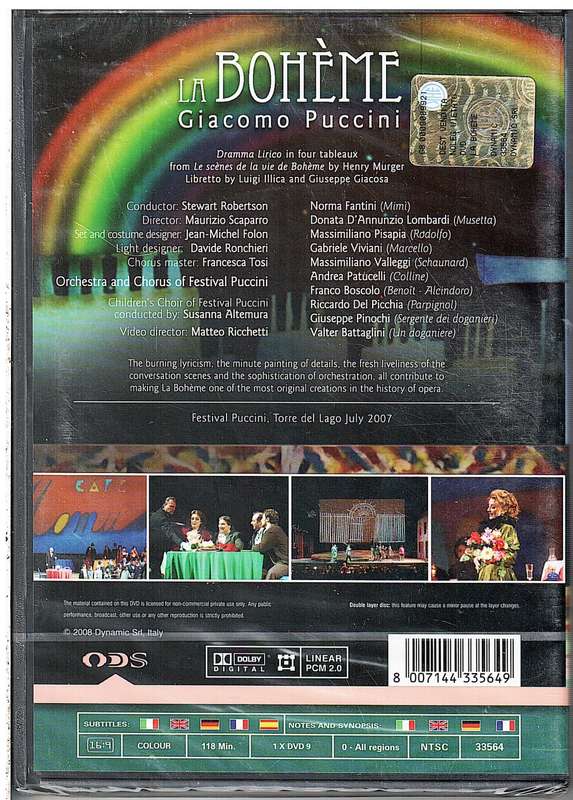Torre del Lago is situated between the Lake of Massaciuccoli and the Tyrrhenian Sea, four kilometres from the beaches of Viareggio on the Tuscan Riviera, 18 kilometres from Lucca and Pisa. Since 1930 the Puccini Festival has been held there in the open-air theatre with around 40 000 visitors every year, just a few steps from Villa Mausoleum where Puccini lived and worked. In November 1924 Puccini wrote in a letter to Giovacchino Forzano, the librettist to Suor Angelica and Gianni Schicchi and director of the first performance of Turandot at La Scala in 1926: " I always come out here and take a boat to go and shoot snipe but once I would like to come here and listen to one of my operas in the open air". This was never to be since Puccini died shortly afterwards in a clinic in Brussels, but his wish stayed in Forzanos memory and a few years later he and Pietro Mascagni started to organize a performance of La Bohème. A provisional theatre was built with the stage on piles stuck in the lake and on 24 August 1930 a touring opera company gave the first performance, directed by Forzano, conducted by Mascagni and with Rosetta Pampanini, Margherita Carosio, Angelo Minghetti and Luigi Montesano among the soloists. The following year Beniamino Gigli was Rodolfo. Since then the festival has grown steadily and attracted many of the worlds leading singers and conductors. In 1966 the present theatre was built and for this years (2008) festival a new theatre is under construction and will be inaugurated for the 150th anniversary of Puccinis birth.
This DVD, filmed during last years festival, is a worthy tribute to Maestro Puccini and the Old Theatre, which has served so well during more than forty years. The stage is wide and occasionally one feels that it is at odds with, at least, the setting of the first and last act of La Bohème, which takes place in a small attic in Paris. However, set designer Jean-Michel Folons inventive solutions reduce the problems and from the outset the viewer is engrossed by the performance. All through the four acts the action takes place on a slightly raised stage-within-the-stage in the shape of an artists palette. In the second act, at Café Momus, the brightly coloured table-cloths become spectacular splashes of paint. A large screen, covering the greater part of the background, is used entertainingly and informatively to underline aspects of the performance. We are shown the roofs of the surrounding houses, as seen from the attic and in the opening scene of act one, where Rodolfo is writing a poem and Marcello is painting obviously he was a fore-runner to Mark Rothko and on the screen well-known and lesser known paintings march past. It is certainly a stimulating production one to return to and enjoy.
And it is not only the visual aspects that are attractive. The cast of mainly young singers is excellent and they act very well. Norma Fantini, who has star billing on the box, is really great as Mimi: expressive, believable and singing with beauty and intensity. Mi chiamano Mimi is a real showstopper. And before that we have heard Che gelida manina sung with such glow, such beauty and with so ringing a high C that one reaches for the booklet to find out which of the world famous tenors it is. We find there the name Massimiliano Pisapia, who should be world famous if there is any justice in this world and probably will be. He is already well established in several countries, including Japan and Argentina. This Turin-born singer has style, is more nuanced than most and has none of the exhibitionist features of his teacher, Franco Corelli. He is also an excellent actor. This also goes for baritone Gabriele Viviani, whose darkish timbre and dashing appearance make him an ideal Marcello. Born in Lucca and having studied with Regina Resnik, he is on the threshold of an international career. Londoners may have heard both these singers last season in recital at St. Johns Smith Square.
Donata DAnnunzio Lombardi is a brilliant Musetta and Andrea Patucelli sings Collines coat aria in the last act with such hushed intensity and warmth that one understands the applause that unfortunately for a few seconds breaks the spell of the performance. It should also be mentioned that Schaunard, a role that is normally allotted to comprimario singers, is here classily sung by the sonorous Massimiliano Valleggi. Stewart Robertson leads his forces in a well-paced performance, further contributing to the overall excellence. A feast for eye as well as ear!
EAN: 8007144335649
Dynamic Srl, 2008
Italy
NTSC - Ensure your player can play this format before purchasing
NEW/SEALED
B06





